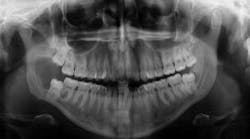A 22-year-old female presents for a comprehensive examination with no chief complaints. After referral to an oral surgeon for wisdom teeth removal, all contact is lost. Seven years later, the patient presents complaining of pain in her jaw that has been getting progressively worse. Based on the clinical findings, can you diagnose this case?
Editor's note: This article first appeared in DE's Breakthrough Clinical with Stacey Simmons, DDS. Find out more about it and subscribe here.
A HEALTHY, 22-YEAR-OLD FEMALE presented for a comprehensive examination. She had no chief complaints and no caries. The patient was referred to an oral surgeon for removal of wisdom teeth. Following that, all contact was lost (figure 1).
Figure 1
SEVEN YEARS LATER, the patient presented with this chief complaint: “Pain in lower right side of jaw that has progressively been getting worse over the course of the last 2-3 months; it feels like I have an infection in my wisdom tooth."
A panoramic was taken, and a large radiolucent lesion was noted to extend from the distal of No. 1 to the distal of No. 32. A significant amount of bone destruction in the mandible was observed. Furthermore, a radiolucency was present distal to the crown on No. 17. Clinically, there was inflamed tissue circa on partially erupted No. 32 that extended up to the distal of No. 2. The area was tender to palpation and unremarkable extraorally (figure 2).
Figure 2
What are your differentials and proposed recommended course of treatment for this patient?
Send your answers to [email protected] or join our Facebook group to discuss this oral pathology case and more. Next month, we will discuss the final diagnosis and recommended treatment for this case.
Editor's note: This article first appeared in DE's Breakthrough Clinical with Stacey Simmons, DDS. Find out more about it and subscribe here.
For more oral pathology articles, click here.
Do you have an interesting oral pathology case you would like to share with Breakthrough’s readers? If so, submit a clinical radiograph or high-resolution photograph, a patient history, diagnosis, and treatment rendered to: [email protected]. We will let you know if we select your case.









